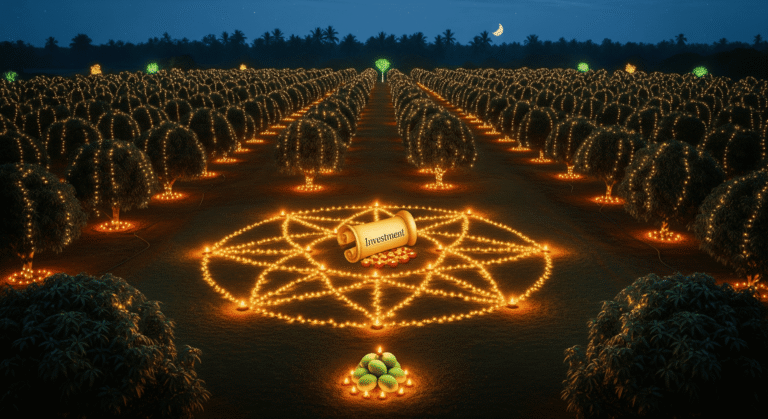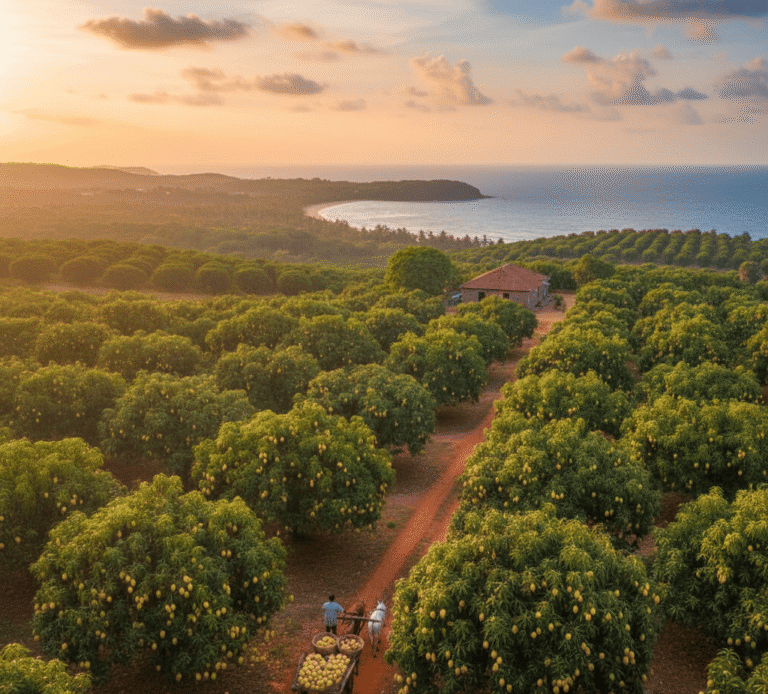The Konkan region of western India harbors one of the subcontinent’s most fascinating collections of supernatural folklore, where ancient spirits and deities intertwine to create a complex spiritual landscape. This coastal strip, encompassing parts of Maharashtra, Goa, and Karnataka, has preserved centuries-old beliefs that offer profound insights into the cultural psyche of its inhabitants and the practical wisdom embedded within traditional superstitions.
The Historical Context of Konkan’s Supernatural Beliefs
Unlike the more prosperous regions beyond the Western Ghats such as Kolhapur and Satara, Konkan has traditionally been a region of modest economic means. The local population has historically depended on fishing, farming, and plantation work involving mangoes, jackfruit, and betel nuts. This dependence on nature’s unpredictable moods—from turbulent monsoon seas that halt fishing activities to droughts that devastate crops—has fostered a deep connection with supernatural forces.
The uncertainty inherent in Konkan’s natural environment has cultivated a spiritual ecosystem where the boundaries between gods, spirits, and demons blur significantly. Local deities often overlap with regional spirits, creating a unique pantheon that reflects the community’s attempt to understand and control their challenging environment.
Traditional Practices and Rituals
Sacred Offerings and Divination
The practice of Bali (ritual sacrifice of goats or chickens) remains prevalent across the region as a method of appeasing supernatural entities. Additionally, the ancient divination practice of Kaul Lavne demonstrates the community’s approach to seeking guidance from the divine realm. This ritual involves adorning a deity’s idol with leaves and posing questions, with answers interpreted based on which leaves fall from the statue.
These practices, while potentially viewed as primitive by modern standards, serve important social and psychological functions within the community, providing frameworks for decision-making and emotional processing during difficult times.
The Fifteen Spirits of Konkan: A Comprehensive Guide
The supernatural taxonomy of Konkan recognizes fifteen distinct types of ghosts and spirits, each with unique origins, characteristics, and cultural significance. These entities transcend simple good-versus-evil classifications, instead representing complex social and moral teachings embedded within folklore.
1. Vetaal – The King of Spirits
Vetaal (known as Betaal in Hindi) occupies the highest position in Konkan’s spiritual hierarchy, serving as the ruler of all spirits. Local priests, called Bhagats, summon Vetaal during possession cases, believing that this spirit king enters the priest’s body to command other spirits to release their victims. The reverence for Vetaal is so significant that temples dedicated to “Vetoba” exist throughout the region.
This belief system provides a structured approach to mental health issues, offering community-based solutions through spiritual intervention when modern medical understanding was unavailable.
2. Brahma Rakshas – The Scholar’s Curse
The Brahma Rakshas represents a powerful cautionary tale about intellectual pride and social responsibility. According to tradition, learned Brahmins who become arrogant about their knowledge and fail to share it with others transform into this spirit after death. The concept serves as a moral reminder about the importance of humility and the ethical obligation to use knowledge for community benefit rather than personal advantage.
3. Samandha – The Ancestral Spirit
Samandha spirits emerge from individuals who die without proper funeral rites or without leaving heirs to perform these ceremonies. These spirits are believed to create obstacles in their descendants’ lives, including educational problems, delayed marriages, and career stagnation. However, when properly appeased through rituals, Samandha can become protective family guardians.
This belief system emphasizes the importance of family continuity and respect for ancestors, ensuring that funeral traditions remain preserved and that families maintain connections across generations.
4. Devchar – The Village Guardian
Associated with the Shudra caste, Devchar spirits originate from individuals who die shortly after marriage. These spirits are believed to reside at the four corners of villages (hence the name “char” meaning four) and can be appeased with annual offerings of coconut, sugar, and chicken. When satisfied, Devchar spirits protect their communities from harm.
5. Munjya – The Bachelor’s Regret
Munjya represents one of Konkan’s most well-known spirits, originating from men who die after their sacred thread ceremony (Munja) but before marriage. These spirits typically inhabit Peepal trees or areas near wells, causing mischief rather than serious harm. The phrase “bara pimpla varcha munjya” (the restless spirit of twelve Peepal trees) describes extremely restless individuals.
Interestingly, this belief may have practical origins, as Peepal trees produce significant amounts of carbon dioxide after dark, making it dangerous to rest beneath them at night.
6. Vir – The Warrior’s Unfulfilled Duty
Vir spirits emerge from unmarried members of the warrior (Kshatriya) caste, serving as the martial counterpart to Munjya. This concept reinforces social expectations about marriage and family responsibilities, suggesting that unfulfilled life duties can lead to spiritual unrest.
7. Khavis – The Victim’s Vengeance
Associated with the Muslim community, Khavis represents the most dangerous spirit category, formed when individuals die violent, tortured deaths. These angry spirits seek revenge indiscriminately, potentially harming innocent people. The concept serves as a stark reminder about the consequences of violence and murder.
8. Girha – The Water Spirit
Girha spirits originate from drowning victims and inhabit water bodies such as rivers, lakes, and creeks. They deceive nighttime travelers by calling their names and leading them into deep water. Local fishermen, particularly those hunting crabs at night, frequently report encounters with Girha.
Legend suggests that obtaining a Girha’s hair grants the possessor worldly success, but losing it brings misfortune. This belief likely served to discourage dangerous nighttime water activities.
9. Chetkin (Daav) – The Dark Practitioner
Chetkin, also known as Daav, represents spirits associated with the Kunbi caste, traditionally involved in domestic work and manual labor. Unlike other spirits, Chetkin may refer to living humans who practice dark arts and control supernatural entities.
10. Zoting – The Coastal Community Spirit
Zoting spirits belong to the Kharvi or Koli fishing communities and are also associated with Konkani Muslims, reflecting the region’s diverse cultural composition.
11. Hadal – The Maternal Tragedy
Hadal spirits emerge from women who die during childbirth or within ten days of delivery. This belief likely served to emphasize the importance of proper post-natal care and support for new mothers during their most vulnerable period.
12. Lavsat – The Widow’s Sorrow
Lavsat represents the spirit of women who died as widows, reflecting the particular challenges faced by widowed women in traditional society.
13. Jakhin – The Wife’s Untimely Death
Jakhin spirits originate from women who die while their husbands are still alive, representing the opposite situation from Lavsat and highlighting the tragic nature of premature death.
14. Bayangi – The Purchased Spirit
Bayangi represents a uniquely transactional supernatural entity that can be purchased through practitioners of dark arts. This spirit brings prosperity to its owner while troubling their enemies, similar to Girha but distinguished by its commercial nature. The concept reflects concerns about the corrupting influence of wealth and power.
15. Chakwa – The Forest Trickster
Chakwa serves as perhaps the most benevolent spirit in Konkan folklore, known for harmless pranks rather than malicious actions. This spirit confuses nighttime forest travelers, causing them to walk in circles until dawn breaks its power. The concept likely served to discourage dangerous nighttime forest expeditions.
Modern Encounters and Contemporary Relevance
The Chakwa Experience: A Case Study
Recent travelers in the Konkan region have reported experiences that mirror traditional Chakwa encounters. One documented case involved motorcyclists traveling from Velas to Anjarle who became lost in forest roads, repeatedly returning to the same locations despite following GPS directions. The experience included encounters with abandoned settlements, mysterious lights, and unexplained phenomena that align closely with traditional Chakwa descriptions.
While scientific explanations exist for these occurrences—construction activities, relocated populations, and natural human reactions to unfamiliar environments—the psychological impact remains significant. The experience demonstrates how ancient folklore continues to provide interpretive frameworks for unusual situations.
The Practical Wisdom in Supernatural Beliefs
Environmental Protection and Safety
Many Konkan spirits serve practical safety functions disguised as supernatural warnings:
- Munjya in Peepal trees discouraged nighttime exposure to high carbon dioxide levels
- Girha near water bodies prevented dangerous nighttime aquatic activities
- Chakwa in forests reduced risks associated with nighttime forest travel
- Hadal emphasized the importance of maternal healthcare
Social and Moral Guidance
The spirit taxonomy also reinforces important social values:
- Brahma Rakshas promotes intellectual humility and knowledge sharing
- Samandha emphasizes respect for ancestors and proper funeral rites
- Vir and Munjya stress the importance of marriage and family continuity
- Khavis serves as a deterrent against violence
Cultural Integration and Religious Syncretism
The supernatural beliefs of Konkan demonstrate remarkable religious inclusivity, with spirits representing various communities including Hindus, Muslims, and different caste groups. This diversity reflects the region’s historical position as a cultural crossroads where different traditions merged organically.
Some spirits have achieved elevation to semi-divine status, receiving worship in dedicated temples and shrines. This transformation from feared entity to protective deity illustrates the dynamic nature of folk religion and its ability to adapt to community needs.
Tourism and Cultural Preservation
Supernatural Tourism Potential
The rich folklore of Konkan presents unique opportunities for cultural tourism that goes beyond conventional beach and heritage site visits. Ghost tours, folklore festivals, and traditional storytelling sessions could attract visitors interested in authentic cultural experiences.
Documentation and Research
Academic institutions and cultural organizations are increasingly recognizing the importance of documenting these traditions before they disappear. The Indira Gandhi National Centre for the Arts and similar institutions support research into folk traditions and their contemporary relevance.
Challenges in the Modern Era
Urbanization and Belief Systems
As Konkan communities become increasingly urbanized and educated, traditional supernatural beliefs face challenges from scientific rationalism and modern lifestyles. Younger generations often view these beliefs as outdated superstitions, potentially leading to the loss of valuable cultural knowledge.
Balancing Tradition and Progress
The challenge lies in preserving the practical wisdom embedded within traditional beliefs while discouraging harmful practices such as animal sacrifice. Educational approaches that explain the historical and psychological functions of these beliefs may help maintain cultural continuity without promoting potentially dangerous activities.
Conclusion: The Enduring Legacy of Konkan’s Supernatural Realm
The fifteen spirits of Konkan represent far more than simple folklore or primitive superstitions. They constitute a sophisticated system of environmental awareness, social regulation, and psychological support that has served coastal communities for centuries. These beliefs demonstrate how traditional societies encoded practical knowledge within supernatural frameworks, creating memorable and emotionally resonant guidelines for safe and ethical living.
Modern visitors to Konkan can appreciate these traditions as windows into the collective wisdom of coastal communities who learned to navigate the challenges of an unpredictable natural environment. Whether viewed as literal supernatural entities or as cultural metaphors, these spirits continue to offer insights into human psychology, social organization, and the eternal quest to understand and control the uncertainties of existence.
The supernatural realm of Konkan thus serves as a fascinating example of how folklore functions as both entertainment and education, providing communities with tools for survival, social cohesion, and moral guidance that remain relevant even in the contemporary world.


